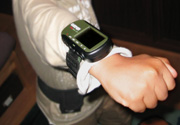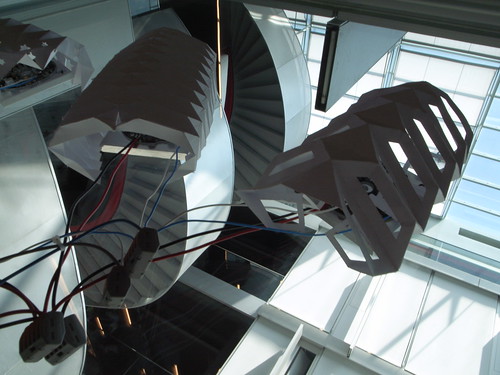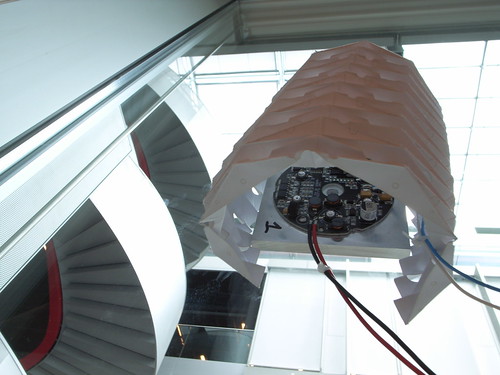Today participating to the Urban Networks and Network Theory at the University of Lausanne. The seminar addresses two issues: 1) The transition from a network/networks of actors, individuals, firms or institutions to the coherent development of a city or system of cities, 2) The potential transfers and links between the various disciplinary and methodological interpretations of the concept “network”. Some notes below about the highlights (raw notes, not well formed).
 (Picture taken yesterday in Zürich)
(Picture taken yesterday in Zürich)
Introduction by Géraldine Pflieger and Céline Rozenblat
There are a variety of scales and aspects which intersect, connect or overlap, and function like networks. The central issue for research on urban networks is to identify, from a transdisciplinary perspective, how each of these networks function and interact in and through the urban space. This will be the central focus of the present seminar.
This will require an examination of the transition from networks of actors to networks of cities through the interlinking of different types of network:
- technical set-up: this refers to the actual physical presence of cities, their morphology, density, topology and topography;
- technological and organisational innovations and their dissemination in urban practices;
- social networks and functional spaces linked largely to the legacies of history but which play an active part in the dynamics of the internal and external networking of cities.
Space of flows: networks between global and local by Manuel Castells
There are interactions between space of flows and ICT. We know that technologies are not a determinant but a mediator. Contrary to futurologists, no demise of cities but we are seeing the most important urbanization phenomenon we have ever seen (we crossed the 60%, 2/3 in 20years).
The most important aspect is the emergence of a new space of flows: of capital, information, technology, organizational interaction, images, sounds and symbols. This leads to a new urban form: the metropolitan region (peter hall+kathy payne use the concept of polycentric metropolis). In most cases, there is not institutional unit in this metropolitan region (even the greater london authority is not sufficient). It's interesting to observe how people call their metropolitan region? You don't say the "SF Bay Area" because San José is bigger than SF. A solution Manuel takes is to use the term employed by TV new: in Los Angeles, it's not LA but "southland" (but south of what?), it's a reference to an area we know it's there.
To Castells, networks explain the concentration in places (you don't grow first and attract). What is important here:
- micronetwork of decision making/initiative = face 2 face (you have to be in financial places, knows who is who, what is who)
- micronetwork of implementation = through electronic media, the network of implementation is macro
This explains the concentration : once these mechanisms is in place, the rest can be explained: infrastructure of communication, services... it develops because there is something to communicate, creation of opportunities because there is money, there is a market... facilities and... jobs... which attracts globally (hence hubs for immigration, multi-ethnic places)... + economies of synergies (2+2 = 5): being in a place where you interact with others leverage innovation
Cities remain the source of creation value, power, social selection and quality of life has nothing to do with it. It's entirely subjective ("can you imagine more boring places than SV?, these people don't go to SF bars, are they here for quality of life? no they're hypnotize by creativity"). As he said "cities become trendy only when they have the power to launch the trends, the rest is consulting for mayors".
When this multi-layer of global network coincides, in a way, then:
- economies of synergy takes place into that node (academic research+tech...)
- this becomes a mega-node: london, NYC (but not Boston)
Elements discussed in the Q&As:
this node concentrate more and more power and wealth
global networks also exclude other dimensions
dissociation between the space of flows and the space of places
power is constructed in the space of communication
the key positions are switchers between networks (politic, business, media...)
the more you connect to the internet, the more you talk within the company
Designing connections: people, places and information by Federico Casalegno (Mobile Experience Lab)
design/communication perspective
goal of the lab: rethink the relationships between people, places and information using cutting edge IT
First part of the talk is about how you can think to map forms of communication (map flow of communication and communities), especially people using mobile phones. How the content of the communication flows between users.
"it is not down on any map: true places never are" Hermann Melville
map use of mobile phone conversations
3 levels: micro/tribal/macro
- micro: conversation+txt+undeground/secret communication (teenagers do not need to talk, they just beep the partner in order to appear, name on the cell phone). This forms an aura of communication: "the womb".
- tribal: one person expert in the tribe about a certain topic publishes about it to the others
- macro: rave parties, someone got the information that there is a party somewhere, send a message to others that you have to meet at a certain place... word of mouth... and you start exchanging content (what style of music? what dj?). you start to have a level of communication. Then everyone gets in the same place
There are different forms of communication, different metaphors: the womb, jellyfish, butterfly, intimate daisy, etc. they are way to understand social networks of mobile phone users
Two projects to rethink communication, place and people:
1) The Electronic Lens (eLense) creates talking landmarks and radically rethink the interactions between institutions, citizens and places. People will point telephone to physical building and get information (magnifying glass), access to information by pointing to an object. Application that recognizes buildings + post voice messages about buildings + start to design communities/group of users that can access to information.
2) Urban garden: rethinking bus stops (with french company RATP)
One node in the city: the bus stop, what is the future of bus stop?
Started to design a prototype: parametric design, integrate and support the urban environment
They also describe the future of the bus stop as a self organized landmark with user-generated content.
Internal interactions: people can see when is the next bus, if there are problems information but also "urban garden" where people can post messages/recommended places/looking for a bass-player in a music band (!).
External interactions: physically reflecting the richness of the local communication on the outside messages posted but also sensors and cameras that measure the traffic/noise production/air pollution that can have negative impact on the "tree" representation.
The whole point of these projects is that technologies as mediators between individuals, local activities. These concepts are prototypes, some aspects will be implemented (la ligne 14!).
Conclusion: framed into the history of cities:
pre-industrial cities consisted essentially of skeleton and skin
then cities in the industrial era had physiologies (water/electric supply systems)
electronic systems are now nervous systems where technologies are embed in the urban fabric
Why do I blog this? This sort of multi-disciplinary meetings is very insightful, it gives context and perspectives to what I'm doing (as well as provide data for foresight work). Ta to Géraldine for the invitation to participate.
 Are those examples of the future of gaming?
Are those examples of the future of gaming?


















